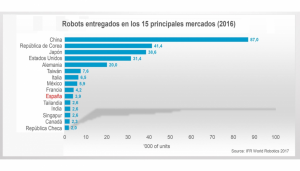The industrial robotics market has represented a significant technological development for the industrial sector. Currently, companies are increasingly automating themselves, gaining a competitive advantage in the market, presenting maximum efficiency in production processes, optimizing time, improving the capabilities of their operators, the quality of the final product, and complying with the different requirements requested by industrial entities. Thanks to the above, the market has been seeing a sharp increase since 2013, the global industrial robotics market recorded a year-on-year growth rate of 12% to 15%.
With the forecast periods made by a specialist in the industrial robotics market, it is estimated that the world stock of operational industrial robots will increase from 1,828,000 units calculated at the end of 2016 to 3,053,000 units, which means an average annual growth rate of 14% between 2018 and 2020.
The industrial sector with the highest demands is the automotive sector, based on a market divided into regions that is dominated by the Asian market. China presented 30% of the total supply in 2016, with sales of about 87,000 industrial robots, followed by South Korea as the second largest market in the world in 2016 with approximately 41,400 units sold and 630 robots installed. This is where manufacturing automation has most increased and where a large demand for industrial robots has been established. The expectation for the global industrial robotics market is increased twice with a CAGR of approximately 5% to 8%.
Currently, it is being suggested that the way to expand this industrial robotics market is by presenting new models of industrial robots to small and medium enterprises; models that are easy to program and operate, flexible, easy to integrate, with a low cost, reduced tariffs and reconditioned and profitable products. Associated with the Industry 4.0, robot manufacturers are already developing a Cloud network where robots will be connected by sensors in order to perform the same tasks and collect data for comparison, purposes which will allow for the optimization of the robot’s movement parameters such as speed, angle or force.
The key today is to propose a simplified trend for the industrial market in order to prove to small and medium-sized companies that betting on robotic automation is worth their time if they want to remain competitive in the market.

